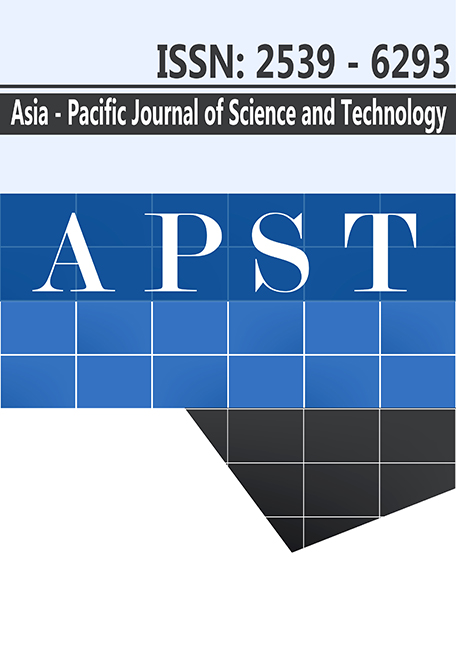Selection of bioinoculants for tomato growth enhancement and pathogen resistance
Main Article Content
Abstract
Bioinoculants were selected based on their ability to produce chitinase solubilized phosphate and demonstrate antifungal activity both on an agar medium and in a quantitative assay using a broth medium. It was demonstrated that Serratia marcescens and Bacillus licheniformis exhibited these attributes to a significantly greater degree (p<0.1) than other strains tested. The effects of S. marcescens, B. licheniformis and a mixed culture of S. marcescens and B. licheniformis on seed germination of tomatoes (Lycopersicon esculentum Mill. cv. Seeda) were evaluated in an in vitro culture. S. marcescens and the mixed culture showed a significantly (p<0.01) higher seed germination. The seedlings grew to a greater height and weight than those recorded when using B. licheniformis or the control (no bioinoculant). S. marcescens and the mixed culture were also studied for their effects on growth and pathogen resistance in pot culture of tomatoes under field conditions. The results demonstrated that both of these bioinoculants exhibited significantly (p>0.01) increased fresh and dry weights as well as greater height of the tomato plants compared to the control. Upon infestation of tomatoes with the pathogenic fungus, Fusarium solani, tomatoes with both bioinoculants showed significantly (p<0.1) increased resistance to the pathogen. It was clear that bioinoculants could enhance growth and pathogen resistance of tomatoes under field conditions as well as under in vitro culture.
Article Details
References
Ahmad F, Ahmad I, Khan MS. Screening of free-living rhizospheric bacteria for their multiple plant growth promoting activities. Microbiological Res. 2008; 163(2) : 173-81.
Gupta R, Bisaria VS, Sharma S. Bioinoculants: More than just plant growth promoting agents. J. Endocytobiosis and Cell Res. 2013; 8-11.
Esitken A, Yildiz HE, Ercisli E, Donmez MF, Turan M, Gunes A. Effects of plant growth promoting bacteria (PGPB) on yield, growth and nutrient contents of organically grown strawberry. Scientia Hort. 2009; 124: 62-6.
Gupta R, Bru D, Bisaria VS, Philippot L, Sharma S. Response of Cajanus cajan and rhizospheric N-cycling communities to bioinoculants. Plant Soil. 2012; 358: 143-54.
Nivedhitha VR, Shwetha BD, Divya DD, Manojkumar NH, Raghavendra RB. Plant growth promoting microorganisms (PGPMs) from bamboo rhizosphere. Adv. Biotech. 2008; 33-5.
George P, Gupta A, Gopal M, Thomas L, Thomas GV. Multifarious beneficial traits and plant growth promoting potential of Serratia marcescens KiSII and Enterobacter sp. RNF 267 isolated from the rhizosphere of coconut palms (Cocos nucifera L.) World J Microbiol Biotechnol. 2013; 29(1): 109-17.
Gupta R, Mthimaran N, Wiemken A, Boller T, Bisaria VS,Sharma S. Non-target effects of bioinoculants on rhizospheric microbial communities of Cajanus cajan. Applied Soil Ecolog. 2014; 76: 26-33.
Benizri E, Baudoin E, Guckert A. Root colonization by inoculated plant growth-promoting rhizobacteria. Biocontrol Science and Technology. 2001; 11: 557-74.
Shanmugaiah V, Mathivanan N, Balasubramanian N, Manoharan PT. Optimization of cultural conditions for production of chitinase by Bacillus laterosporousn MML2270 isolated from rice rhizosphere soil. African J. Biotech. 2008; 7(15): 2562-8.
Imoto T, Yagishita K. A simple activity measurement of lysozyme. Agric. Biol. Chem.1971; 35: 1154-56.
Mostapha NK. Biological control of Rhizoctonia solani, the causal agent of rice sheath blight by antagonistics bacteria in greenhouse and field conditions. Plant Path. J. 2004; 3: 88-96.
Son HJ, Park GT, Cha MS, Heo MS. Solubilization of insoluble inorganic phosphates by a novel salt- and pH- tolerant Pantoea agglomerans R-42 isolated from soybean rhizosphere. Biores. Technol. 2006; 97(2): 204-10.
APHA AWWA, WEF. Standard Methods for the Examination of Water and Wastewater. 19th edition. Baltimore: United Book Press; 1995.
International Seed Testing Association. International Rules for Seed Testing. Bassersdorf: International Seed Testing Association (ISTA); 2005.
Murashige T, Skoog F. A revised medium for rapid growth and bioassay with tobacco tissue cultures. Physiol. Plant. 1962; 15: 473–97.
Kamil Z, Rizk M, Saleh M, Moustafa S..Isolation and identification of rhizosphere soil chitinolytic bacteria and their potential in antifungal biocontrol. Global J. Molec. Sci. 2007; 2(2): 57-66.
Okazaki K, Tagawa K. Purification and properties of chitinase from Streptomyces
cinereor. J. Ferment. Bioeng. 1991; 71: 237-41.
Someya N, Nakajima M, Watanabe K, Hibi T, Akutsu K. Potential of Serratia marcescen of rice sheath blight. Biocontrol Sci.Technol. 2004; 15: 105-9.
Liu L, Kloepper JW, Tuzun S. Introduction of systemic resistance in cucumberby plant growth-promoting rhizobacteria : duration of protection and effect of host resistance on protection and root colonization. Phytopathol. 1995; 85: 1064-8.
Khan M, Patel CB. Plant growth promoting effect of Bacillus firmus strain NARS1 isolated from Central Himalayan region of India on Cicer arientnum at low temperature. African Crop Science Conference Proceedings. 2007; 8: 1179-81.
Khan MS, Zaidi A, Wani PA, Oves M. Role of plant growth promoting rhizobacteria in the remediation of metal contaminated soils. Environ. Chem. Lett. 2009; 7: 1-19.
Ahemad M, Kibret M. Mechanisms and applications of plant growth promoting rhizobacteria: Current perspective. J.of Kong Saud University Science. 2014; 26: 1-20
Bhattacharyya PN, Jha DK. Plant growth-promoting rhizobacteria (PGPB): emergence in agriculture. World J. Microbiol. Biotechnol. 2012; 28: 1327-50.
Deshmukh PB, Gupta VR. Co-aggregation of microbes for efficient phosphorus
solubilization. J. Plant Disease Sci. 2009; 4(2): 218-21.
Chookeitwattana K, Maneewan K. Screening of efficient halotolerant phosphate solubilizing bacterium and its effect on promoting plant growth under saline conditions. World Appl. Sci. J. 2012; 16(8): 110-7.
Garcia JAL, Brobanza A, Ramos B, Palomino MR, Manero FJG. Effect of inoculation of Bacillus licheniformis on tomato and paper. Agronomic. 2004; 24: 169-76.
Rojas A, Hoguin G, Glick BR, Bashan Y. Synergism between Phyllobacterium sp. (N2-fixer) and Bacillus licheniformis (P-solubilizer), both from a semiarid mangrove rhizosphere. FEMS. Microbiol. Ecol. 2001; 35(2): 181-7.
Mukesh Kumar DJ, Balakumaran MD, Kalaichelvan PT, Pandey A, Singh A, Raja RB. Isolation, production and application of extracellular phytase by Serratia marcescens. Asian J. Exp. Biol. Sci. 2011; 2(4): 663-6.


